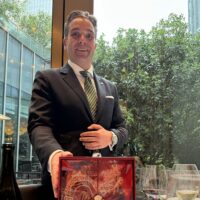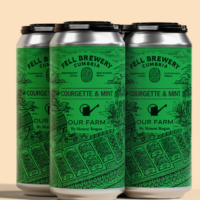Different harvests

The wine is fermented separately then blended. Romero continues: “The alcohol is now 13% ABV, and the idea is to keep it at that level. It used to be much higher – you can still find many examples from Salta that are much higher – but there’s no point. Bitterness from too much sun exposure is very common in Torrontés, but if you do different harvests and control the fermentation temperature, you can avoid this.”
Carolina Garicoche, head brand ambassador at Grupo Peñaflor, which owns El Esteco in Salta, agrees that subtlety is the way forward.
To make its old vine Torrontés, which is sourced from a vineyard planted in 1945, El Esteco uses natural yeast, concrete eggs and no oak.
Garicoche explains: “Torrontés is a very aromatic variety, with a grapey, fruit-forward nose. Our old vine Torrontés is produced in a different way to give the wine more elegance and delicacy. The wine has 15% of whole bunches added during the first third of fermentation, after which they’re removed. It’s a more full-bodied style, which is aged for seven to eight months on its lees. We always try to have balance, even when the region naturally produces high sugar.”
Producers of Chardonnay are likewise pushing boundaries. From high altitude vineyards in the Uco Valley to those located in the southernmost limits of wine production in Chubut, in Patagonia, variety is the order of the day.

For Zuccardi in the Uco Valley, improved understanding of each of its estates through extensive soil analysis has afforded wines with a “purer” expression.
Laura Principiano, agronomist at Familia Zuccardi, says: “For us, the future is the region and the place. Understanding what happens in different areas is essential. We’re sure Mendoza is a fantastic place for whites, but we should be talking more about the specific places.”
Winemaking began to change at Zuccardi in 2010, with the producer now shirking stainless steel in favour of concrete amphorae. “In the past our Chardonnay was different,” Principiano says. “But when we moved to the Uco Valley we sourced our grapes from different areas and changed our methods in the winery. We altered our picking times, opting for an earlier harvest. In the past we used commercial yeasts and new barrels. Now we use natural yeast and old barrels.”
Sofia Pescarmona, co-owner of Bodega Lagarde, has likewise taken the time to properly understand her vineyard.
“This is a long-term project,” she says, revealing her intention to release ‘single plot’ wines produced from individual blocks in her vineyard in Gualtallary in the Uco Valley. We’re making good wine, but there’s room for improvement, she says. “For me, the vines need to get slightly more mature. We have seven Chardonnay clones planted in seven parcels. Throughout the entire vineyard, we have six soil types, and Chardonnay is planted on three of them.”
Lagarde produces two Chardonnays in its Guarda collection. Both are made without malolactic fermentation, and one is 60% aged in French oak barrels for 10 months, while the other remains oak-free.
“We make the same wine and they both have the same price point,” Pescarmona says. “This is important. You can have a great wine without oak. The price should reflect the land, how the grape expresses itself and the wine’s ageing potential.”
Known for pioneering Viognier in Argentina, her estate makes single varietal expressions, as well as using the grape in its Proyecto Hermanas white blend.
“After first planting Viognier in 1989, it took us a while to find our own distinctive style,” Pescarmona adds. “In the end, we went for something that was simple and elegant – we use stainless steel and no oak, letting the grape express its varietal character.
“Viognier can be a tough sell. There’s a lack of knowledge about it, and there are not many hectares in the world, so it can be hard to push when it’s not a mainstream variety. But it’s our USP.”
While producers drill down on detail in the Uco Valley, wineries in Chubut are just finding their feet. Casa Yagüe, near Trevelin, planted its first vines in 2014, and released its first vintage in 2017. With an entirely different climate to Mendoza, with frosts almost a year-round threat, the family-owned winery is experimenting with oaked and unoaked Chardonnay, and is planning to release a sparkling made from the variety.
Family member, head of PR and trainee winemaker Juli Yagüe, explains: “We want to do a lot of things but we’re going step by step. We are working on a traditional method sparkling wine made from Chardonnay, as we can obtain high levels of acidity here.”
Taking things slowly

Otronia, by far the largest producer in what is a small-volume region, is similarly taking things slowly. With 50ha out of a total 65ha under vine in Chubut, Otronia began planting in 2012, predominantly with Chardonnay and Pinot Noir, but also with some Gewürztraminer, Pinot Gris, Merlot and Malbec.
Despite its youth, the estate has already divided its vineyard into blocks, producing a Chardonnay made from a blend of two selected sites. Produced without malolactic fermentation, and aged for 16 months in un-toasted foudres, the wine is decidedly modern in its approach.
“We’re learning a new way of winemaking in a new world of wine production,” says commercial director Maximo Rocca. “We have a very arid climate, with 200mm of rainfall per year. The most important thing in Sarmiento is the wind – it can reach as high as 110mph here.”
With netting used to steady the vines in the wind, the dry, blustery conditions create thicker-skinned grapes with yields as low as half a kilo per plant.
“Our winemakers decided not to talk about terroir but micro-terroir,” says Rocca. Like Casa Yagüe, Otronia will also be releasing traditional method sparkling wine, one made from Chardonnay and the other from Pinot Noir, which will spend between two to three years ageing on their lees.
While some companies are experimenting with the likes of Marsanne, Roussanne and Gewürtztraminer, there is also a desire to preserve Argentina’s viticultural heritage. Thus, varieties like Sémillon and Chenin are being recovered and replanted, while others work to protect 54 different grape varieties within the so-called Criolla family.
The 703ha of Sémillon and 1,886ha of Chenin planted in the country are some way from challenging Torrontés (21% of whites planted) and Chardonnay (16% of whites planted).
Nevertheless, putting Torrontés, Chardonnay, Sauvignon Blanc, Chenin Blanc, Viognier, Sémillon and Riesling aside, there are over 16,000ha of ‘other’ white grapes planted, constituting almost 43% of the area devoted to white varieties. For red grapes, once the top 10 varieties are excluded, the figure is just 9%. While accounting for only 19% of Argentine vineyards, white grapes make up in diversity and excitement what they lack in volume.




